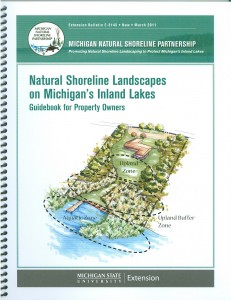Waterfront property owners are increasingly recognized as having unique opportunities to protect and enhance shorelines.

Shoreline DIY for property owners. Photo: Michigan Natural Shoreline Partnership
Now a collaboration of conservation agencies and professionals called the Michigan Natural Shoreline Partnership is giving them help. The group recently released a handbook titled, “Natural Shoreline Landscapes on Michigan’s Inland Lakes: Guidebook for Property Owners.”
The book supports the use of natural vegetation to protect property that fronts bays, streams and lakes. The idea is to mimic the wilderness of an undeveloped shoreline to preserve the natural habitat of the lakes’ ecosystem.
Besides controlling erosion along the shores, natural buffers also provide habitat for rare fish and wildlife, according to the book.
The book is easy to read. It doesn’t have scientific jargon — just simple practical methods. It begins with an overview of the general health of inland lakes then escalates into more specific conservation practices. The illustrations demonstrate healthy shorelines and are useful to those who just want to skim through.
The book also mentions some poor but often-used practices. Seawalls and rock riprap are often resorted to when erosion begins. But they are expensive, disturb fish spawning areas and bar water-dependent animals’ access to the habitat they need.
Also targeted in the book are contractors, landscape professionals and local and state policy makers.
To help owners and developers understand their role, the authors present the shoreline ecosystem as a simple food web. Each level of the web illustrates the chain reaction of disruptions when the shoreline is disturbed.
The third chapter details steps to planning a natural shoreline landscape. A map illustrates zones of a healthy and well-designed shoreline.
While the main goal of the handbook is to restore the natural wildlife habitat of shorelines, it doesn’t overlook the needs of owners. It suggests native trees, shrubs, wildflowers, sedges and aquatic plants that owners can plant that are attractive and control erosion. It suggests landscape designs that attract wildlife and discourage nuisance animals.
This is not just a ‘how to’ book. There are practical steps presented as case studies detailing how different shoreline problems have been naturally and successfully resolved. The studies come with cost estimates and a list of plants and other materials used in remediation.
Lessons from the handbook:
- Plan to ‘lakescape’ your lake frontage with at least three-quarters of plants within the zone of the highest reach of lake water at high tide.
- Avoid lawns. Plant trees and shrubs to enhance views. Grasses, sedges and wildflowers can fill the gaps and provide color.
- Learn the laws and zoning requirements regarding your lake front property.
- Native plants thrive best.
- Remove invasive species before planting.
- Maintain your shoreline till native species take root.
“Natural Shoreline Landscapes on Michigan’s Inland Lakes: Guidebook for Property Owners” is a collaboration of Michigan State University Extension, Michigan Department of Natural Resoures, MSU-Department of Horticulture, Michigan Sea Grant and JFNew. It is available at MSU bookstore at: www.bookstore.msue.msu.edu Publication # E-3145
Far too many shorelines have been destroyed by the use of sheet-pile seawalls. The DNR/DEQ should simply not permit any more to be installed. Leave it natural!